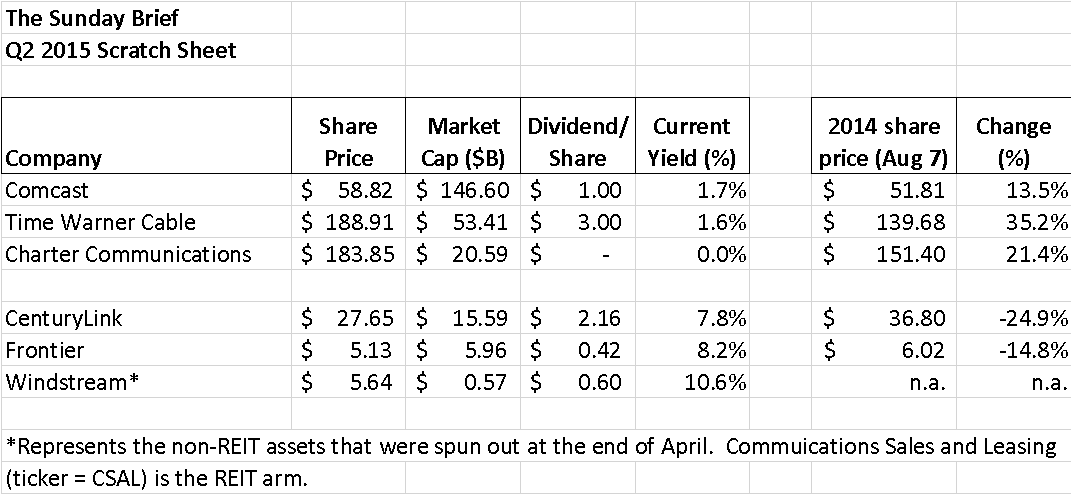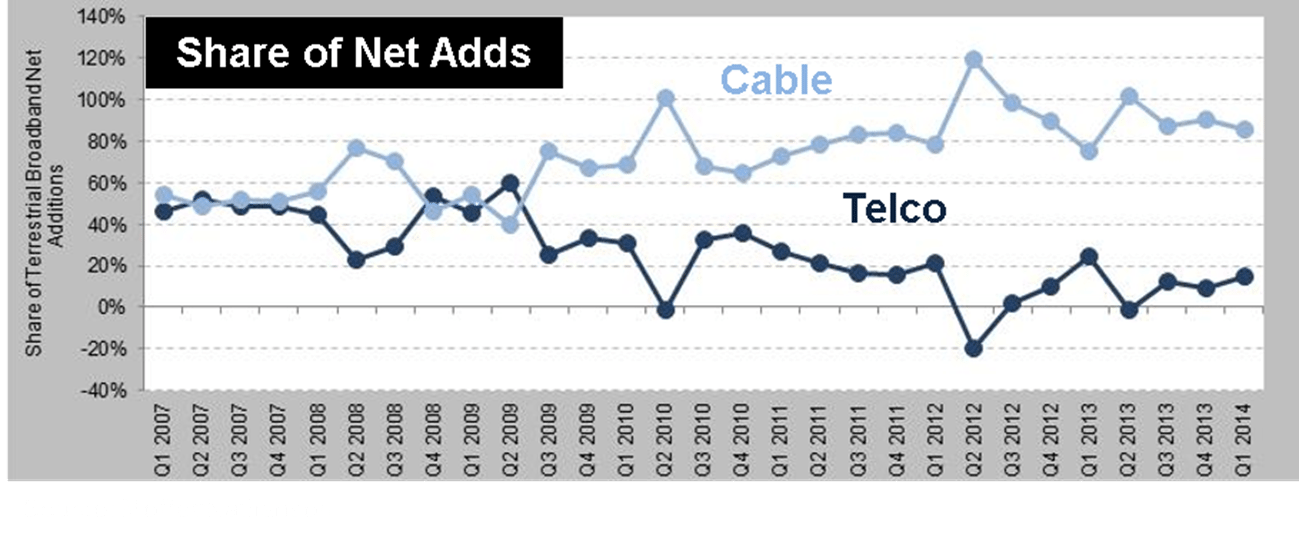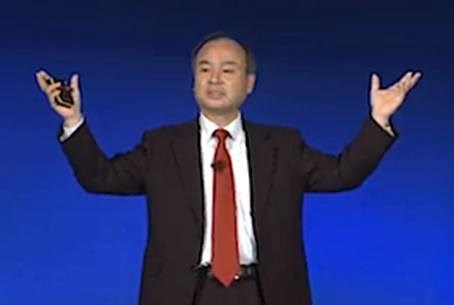The telco mentality
Last week we rounded out telecom and cable earnings. To no one’s surprise, cable is trouncing its competitors and quickly turning into the favored high-speed data provider for both small business and residential markets. Here are some selected extracts regarding cable vs. telco performance (I have excluded AT&T and Verizon Communications from this analysis as much of their market value is dependent on their wireless business):
The news flash from this table is that investors are not picking cable for their high dividend (Comcast and Time Warner Cable are below 2% and Charter does not pay one), but have ceased to have confidence in the ability of traditional telephony providers to pay the current dividend rate into perpetuity, which provides the basis for the stock value. This has caused yield-oriented investors to look elsewhere for dividend stability.
In an effort to reassure investors that they can sustain the dividend, the incumbents reduced headcount (CenturyLink announced an additional 1,000-employee reduction last week) and cut capital (CenturyLink reduced 2015 capital estimates by $200 million last week). This results in underinvestment in fiber/speed upgrades, which allows cable to increase its relative market share and impacts profitability expectations. And the cycle begins again.
This is of course a broad generalization – each company has responded to this cycle in different ways. But there is a “telco mentality” that permeates CenturyLink, Frontier and Windstream that is underpinned by several principles:
1. We cannot grow market share on legacy products and services – the only thing we can manage is their rate of decline.
2. We must hit our current year budgets, regardless of market opportunities.
3. We will always be the provider of last resort.
4. We will never sell more speed than what we think customers need.
5. Businesses will always pay more than residences for the same service.
6. Cable will never be competitive in cross-territory bids (medium and large business).
7. Beyond all else, we must preserve revenue in order to preserve cash flow and, ultimately, the dividend.
Like many of you, I started my Sprint career in the local telecommunications division engineering and operations division. At that time, the LTD still had a revenue department made up of top-notch regulatory, finance and sales professionals. Relative to their industry peers, this was a fairly progressive bunch. As 800 services (more access revenue), dial-up (more interconnection expenses) and eventually DSL proliferated, the LTD was there with additional offerings. As long as access lines and special access services to business customers grew, things were good.
In 2001, things started to change. Access line growth began to slow, driven by a mild recession and competition from a newfangled device called a cable modem. From 1998 to 2000, North American cable modem penetration increased from 550,000 to over 5 million (more here). From 2001 to 2005, that figure grew to more than 17 million.
While access line growth slowed (or was slightly negative – 1% to 3% declines per year was not uncommon), the lines lost took less revenue away from incumbent telcos than traditional primary voice lines. While any access line represented revenue loss and potential stranded investment, there were not enough points to paint a straight (downward) line. And, for many incumbents, long-distance revenue (a familiar market to many telcos) was masking voice losses.
Then came cable’s triple play, starting with Cablevision Systems in 2004 and Insight Communications in 2005. Originally offered to counter the increasing threat from satellite, both companies hit access lines hard, with Cablevision scoring more than 200,000 phone line acquisitions in its first six months of service (detailed article here). As soon as the long-distance opportunity began it had vanished (see this vintage 2010 column for a good view of the access line loss AT&T experienced after it purchased BellSouth).
The incumbent telecommunications providers were still generating increased earnings thanks to consolidation synergies, and DSL line growth continued to be reasonably strong through 2006. Then came the mass deployment of DOCSIS 3.0 and the decision by Comcast and others to “stuff the stocking” – offer more bandwidth for the same price rather than participate in the death spiral of DSL (“for life” offers that would barely accommodate Web downloads in 2007, let alone Netflix today). Cable took the “Faster. Better” approach.
Since the end of 2007, DSL has struggled mightily against cable. AT&T U-verse and Verizon Communications FiOS (a.k.a, “fiber for the rich”) became the strategic initiatives, while the rest of the planet was put on autopilot. In the process, cable’s share of decisions turned from 55-60% to 80-90% over a three-year period, even with the growth of fiber-based alternatives (chart courtesy of Moffett Nathanson):
The traditional telecommunications providers are in real trouble. They are underinvesting in their local franchise and, as a result, could cede market leadership to cable in entire states or regions by 2017 (some metropolitan areas, such as Omaha, Neb., ceded voice-line leadership years ago). Cable is increasing commercial and residential bandwidth investment, upgrading to higher speeds and connecting shopping centers across the country. A broad-based change is needed to the telco infrastructure and a new mentality is needed. We propose one that looks like this:
1. Dividends are an important representation of cash flow success. We cannot give away cash at a time when our core franchises are under assault. Therefore, the dividend will be suspended until we can command a share of decision advantage vs. cable.
2. We will not assume that the consumer (or business) cannot consume more bandwidth until further notice.
3. We will align our cost structure to generate a profit yet have a similar value proposition to Google Fiber ($70 per month for 1 gigabit per second speeds and no caps).
4. We will charge consumers and businesses the same rate for equivalent services.
5. We will align our long-term interests with short-term realities but, in the absence of a tie, will choose to manage the business for the long term.
6. Other strategic businesses (global hosting and associated services) are also important, and we will win on multiple fronts.
7. We will not get caught flat-footed again.
The traditional telecommunications providers can restore their luster, but it’s going to involve a change in thinking. If John Legere can be cloned, there’s a job for him.
Sprint: A better network for half of the capex
In next week’s column, we’ll discuss Sprint’s earnings in greater detail, but I cannot let the last conference call go without mention. Last Monday evening, Sprint named Tarek Robbaiti (FlexiGroup, Telstra, CSL, Orange) as CFO and Gunther Ottendorfer (Telekom Austria, Optus SingTel) as COO, technology. John Saw, who was promoted to CTO (the title held by Stephen Bye, who left Sprint in July), will report to Gunther.
On Tuesday morning, Sprint announced mixed earnings. Sprint Chairman Masayoshi Son tried to reassure investors on the conference call that his plan was lock tight with the following assessment of the U.S. wireless industry (this quote is from Seeking Alpha and verified from the audio transcript on Sprint’s investor relations website):
“As you may know, Japan has the best network in the world. To me, every time I come to the States, I said this network in this country is not something that you should be proud of. It is actually very bad. It’s not just Sprint, even Verizon, AT&T and T-Mo, all network is pretty bad. I’m want to say U.S. invented Internet, U.S. invented telephony but network is not something that you should be proud of.
“So I would say the network that we created in Japan is much, much more superior. That’s a fact: coverage, the speed and all the integration. However, within Japan, SoftBank spent almost half in capex compared to our competitor, but the result of our network coverage, the speed is No. 1. So what we’re good at is spending less in capex and create a No. 1 network. Of course, it’s easy to spend money and get the result, but if you have less money and then still want to achieve the No. 1 network, you have to use brain instead of money and muscle.
“So we have used brain a lot, and came up with all kinds of unique solutions that other companies do not have. We created by ourselves. So we discussed with Sprint engineers and SoftBank engineers and initially the reaction was the U.S. environment is different. However, after all these studies, most of the key fundamentals are exactly identical.
“So SoftBank has 2.5 GHz spectrum, Sprint has 2.5 GHz spectrum. Both of us are using TD-LTE on top of FDD-LTE. So the common practice, common know-how, common technologies could actually apply. So I am now very, very confident that Sprint will be able to create equal or better. In my view, it will be a lot better network very soon with much lower capex.”
This is a more powerful statement after a few reads. The way I interpret this is that SoftBank’s extensive experience with 2.5 GHz (specifically the issues of working with high-band spectrum inside of buildings and in hard-to-reach metro locations) can be ported/leveraged by Sprint to create a better network for a fraction of the cost of their competitors ($15 billion over the next three years).
T-Mobile US column erratum
I rarely miss on research items (as opposed to opinions and prognostications), but last week I was quickly reminded by T-Mobile US employees that I had made a mistake when I stated that T-Mobile US faced a reset headwind on their 10 gigabytes (four lines) for $100 offer. In mid-March, T-Mobile US extended that promotion for current customers indefinitely (more here). The rest of the issues described in last week’s Reality Check still hold. Thanks for the instant feedback, and apologies for the error.
I actually had several requests asking what I meant by my statement about T-Mobile US’ driving force (that the benefits of a data-first strategy drive the company as opposed to “fixing” downline processes such as calls to care and churn). I don’t know how to say this more clearly, but when you start by removing the pain points from the customer experience (elimination of contracts, bill shocks, slow networks, etc.) and you replace that with features that the customer values (larger data allotments, promotional rates for life, Pandora/Spotify/Apple Music included for nearly all plans), those customers are going to be loyal.
Stimulating smartphone loyalty is critical to establishing and growing a wireless customer base. T-Mobile US has moved to No. 3 because it started solving upstream problems. They are a good case study for the entire industry.
Jim Patterson is CEO of Patterson Advisory Group, a tactical consulting and advisory services firm dedicated to the telecommunications industry. Previously, he was EVP – business development for Infotel Broadband Services Ltd., the 4G service provider for Reliance Industries Ltd. Patterson also co-founded Mobile Symmetry, an identity-focused applications platform for wireless broadband carriers that was acquired by Infotel in 2011. Prior to Mobile Symmetry, Patterson was president – wholesale services for Sprint and has a career that spans over 20 years in telecom and technology. Patterson welcomes your comments at jim@pattersonadvice.com and you can follow him on Twitter @pattersonadvice. Also, check out more columns and insight from Jim Patterson at mysundaybrief.com.
Editor’s Note: The RCR Wireless News Reality Check section is where C-level executives and advisory firms from across the mobile industry share unique insights and experiences.





